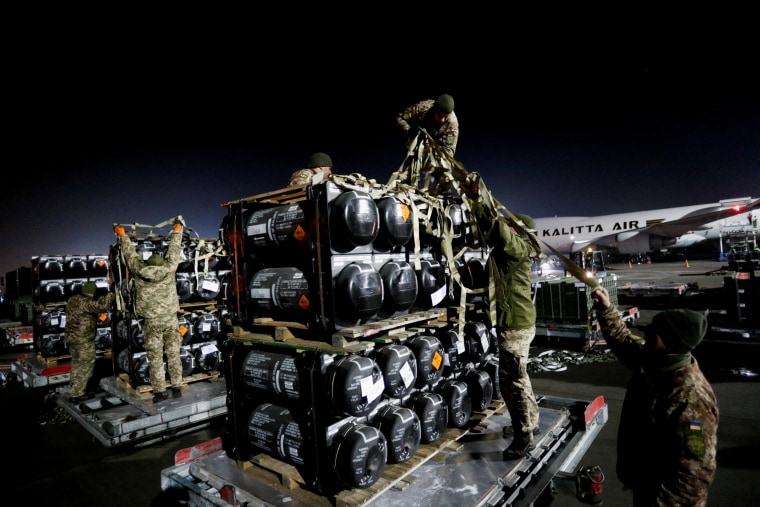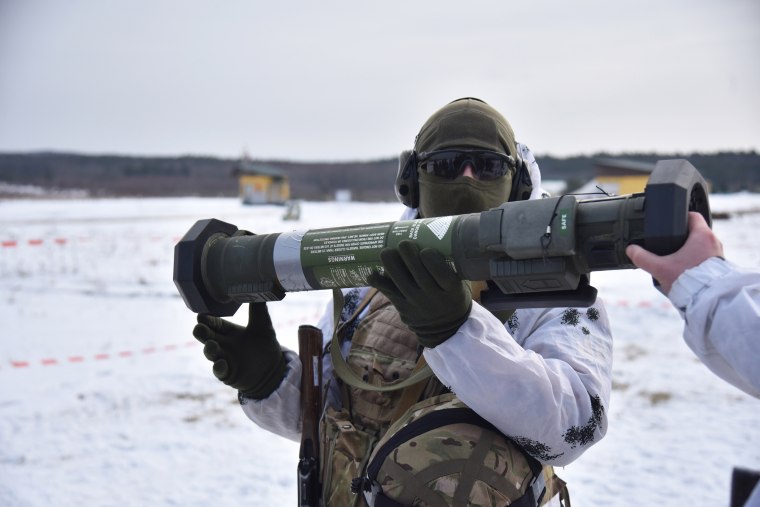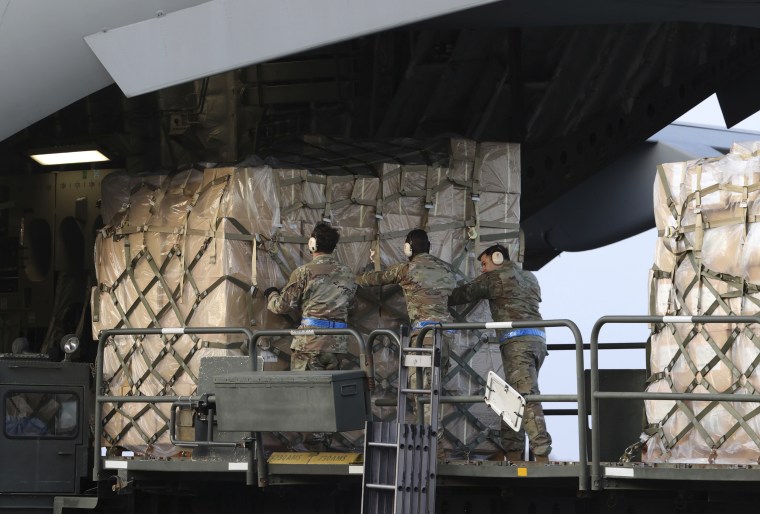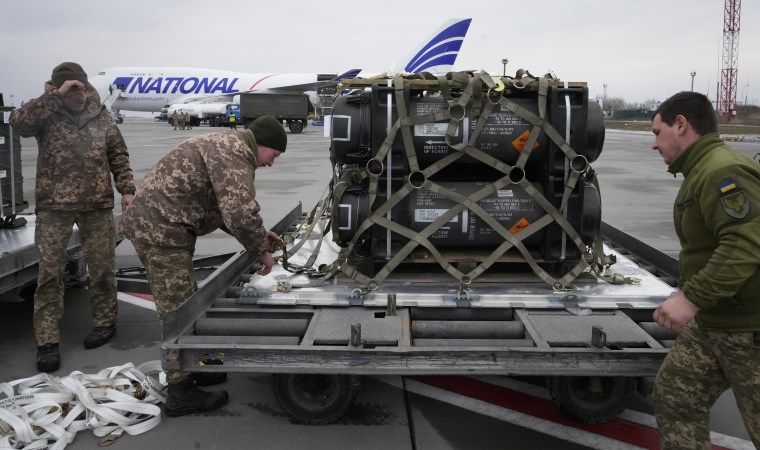Russia’s faltering campaign in Ukraine and the relative success of Ukrainian forces in fending off the invasion have forced the U.S. and other NATO governments to consider providing military aid for Kyiv on a scale Western leaders never anticipated, current and former officials say.
It’s not clear, however, that the U.S. and other NATO members can sustain even the current level of weapons deliveries.
The White House says that it has moved swiftly in an unprecedented way to get weapons in the hands of Ukrainians fighting the Russian troops, and that U.S. officials are working with NATO allies to keep the arms moving to Ukraine.
Since the Russian invasion began on Feb. 24, U.S. cargo planes have unloaded hundreds of anti-aircraft Stingers, thousands of anti-tank weapons, millions of rounds of ammunition and other gear destined for Ukraine’s armed forces, according to the White House. The weapons deliveries to Eastern Europe came as President Joe Biden recently approved more than $1 billion of military assistance for Ukraine in less than a week.

But these commitments threaten to deplete the existing supplies of some munitions, according to John Schaus of the Center for Strategic and International Studies think tank.
Under recent decisions, the United States will deliver about 4,600 Javelin anti-tank missiles to Ukraine, the White House says. That would account for more than half of the 8,885 Javelins the Defense Department bought in the past 10 years, said Schaus.
Ukraine’s ambassador to Britain, Vadym Prystaiko, warned last week that its current supply of arms will run out soon as their forces are burning through the supplies at a rapid rate. Canada said it will now purchase military gear to send to Ukraine as it could not draw any further from its own supplies without undermining its own defense needs.
In Washington, lawmakers from both parties have expressed concern the Biden administration has yet to lay out a plan on how it will replenish the stocks of weapons being provided to Ukraine. The chairman of the House Armed Services Committee, Rep. Adam Smith, a Democrat from Washington, and the ranking Republican member, Rep. Mike Rogers of Alabama, recently wrote a letter to Defense Secretary Lloyd Austin demanding the Pentagon explain how it intends to ramp up production to replace Stingers sent to Ukraine.
Now members of Congress and officials in Kyiv are calling for a more ambitious approach that would help Ukrainian forces roll back the Russians instead of merely holding them to a stalemate, a goal that would require a wider range of weapons and long-term plans for an open-ended war.
A bipartisan group of lawmakers, including senators who visited Eastern Europe this week, are urging the administration to aim their efforts at helping Ukraine deliver a decisive defeat to Russia.
“The U.S. mission in Ukraine must go beyond ensuring the country merely has the means to defend itself against Russian aggression,” said a bipartisan letter from 25 lawmakers. “The strategy must deliver Ukraine necessary weapons to defend itself, counter the Russian forces’ advance, and give the Ukrainian people a chance to win this war,” the lawmakers wrote in a letter Tuesday.

Ben Hodges, a retired U.S. Army general who served in Afghanistan and oversaw troops in Europe, said the administration needed to shift its goals in Ukraine and give additional weapons that could take out incoming Russian missiles and warships off the coast.
“There is not the sense of urgency that is needed to help the Ukrainians turn the tide. It seems as if we are giving them enough to keep them from losing but not enough to help them win,” said Hodges.
U.S. lawmakers also have demanded a full accounting of the weapons sent to Ukraine so far and of what’s left in U.S. and European stocks.
Where are the drones?
Critics, including Republican lawmakers, former U.S. diplomats and military officers and Ukrainian officials, say the Biden administration has consistently adopted an overly cautious stance on aiding Ukraine, hesitating to green-light the delivery of certain types of weapons — such as armed drones and Stingers — to avoid provoking an aggressive response from Moscow. They argue that the administration had to be pressured into almost every significant step it has taken so far to help Ukraine.
Despite appeals from Ukraine and from lawmakers, the administration did not approve American shipments of Stingers or armed “kamikaze” drones until after the Russian attack was launched in February. Significant numbers of anti-tank Javelin weapons did not start flowing until January.
As of Wednesday, small “kamikaze” Switchblade drones, recently approved by the administration, had yet to be delivered, according to the Pentagon. A larger, more powerful version of the Switchblade drone was not approved in the administration’s weapons package.
The administration initially chose not to share targeting intelligence with Ukraine, but after criticism from Congress, it relented.

In blunt language, Ukrainian President Volodymyr Zelenskyy has rebuked NATO countries, saying they are dithering about providing help while Russian shells and missiles rain down on Ukrainian cities.
Although Zelenskyy has made repeated public pleas, the White House remains opposed to helping Poland or other countries provide Soviet-era fighter jets to Ukraine, saying the planes are of limited utility and could risk escalating tensions with Moscow. Ukrainian pilots disagree, saying in interviews that their fighter aircraft are undermining Russia’s air attack but that they are outnumbered and need more planes and better radar.
Ukraine has also asked for more sophisticated S-300 air defense systems that can hit aircraft at a higher altitude, but Eastern European countries say they are not ready to deliver those to Ukraine until they acquire a replacement from the U.S. or other NATO states. U.S. officials say the issue remains under discussion.
Rogers, the ranking Republican on the House Armed Services Committee, said the Biden administration “has consistently slow-walked sending critical lethal aid to Ukraine.”
“The Biden White House should be haunted by the knowledge of the impact that U.S. Stingers, more Javelins, Switchblades, and air-defenses, would have had if they were provided pre-invasion,” Rogers said in an email.
Sen. Chris Murphy, D-Conn., a member of the Senate Foreign Relations Committee, defended the administration, saying it has moved rapidly in an unparalleled situation, with the United States explicitly arming an opposing force fighting the Russians. Even during the Cold War, the U.S. did not overtly provide weapons to Moscow’s adversaries, he said.
“There’s not a single country in the world that’s done more for Ukraine than the United States, even though we’re on the other side of the world,” Murphy said.
Murphy said there are “very few signs that the administration is taking its foot off the accelerator in order to send messages to Putin.”
John Herbst, a former U.S. ambassador to Ukraine who urged the administration to move more decisively to arm and equip Ukraine before the invasion, said the current effort to send weapons to Ukraine “may end up being enough, but it’s far from what it should be.”
The administration rejects accusations that it has moved too slowly, or that Ukraine is not getting the weapons it needs. It also points to military training carried out over the past several years by the United States and other allies that is now bearing fruit on the battlefield.
“Armchair generals keep searching for some magical weapon that would be the difference maker, when the actual difference maker is staring them in the face — it’s the thousands of weapons of all sorts we’ve already delivered, which have kept the Ukrainians in the fight, sent the Russians into retreat, and ultimately will lead to Putin’s failure,” said a U.S. official, who was not authorized to speak on the record.
Marc Polymeropoulos, who once oversaw clandestine operations in Russia and Europe for the CIA, said it was not realistic to provide Ukraine with everything it has asked for.
“Instead, we should be giving them what they actually require, based on the needs-based assessments of professional CIA and special operations officers who presumably maintain routine contact with their Ukrainian counterparts,” he said.
Polymeropoulos said the Biden administration’s caution has been frustrating at times, particularly amid reports of debates at the White House National Security Council over legal objections to various courses of action.
“It’s always nasty to see how the sausage is made, but ultimately it comes out tasting pretty good,” he said. “The administration was initially overly cautious over unfounded fears of escalation, but after pressure from the Hill, and in particular events on the ground, ultimately we wound up doing the right thing.”
With Russian forces struggling to advance and even pushed back around Kyiv and other battlefronts, and amid estimates from U.S. officials of high casualties among Russian troops, it appears the effort to arm the Ukrainians is proving effective, according to Polymeropoulos.
Given that the Ukrainians are currently “kicking the crap out of the Russians,” he said, the overall effort seems to be working.

